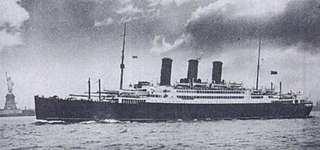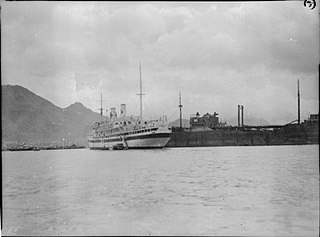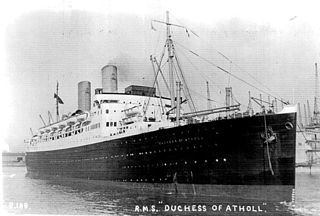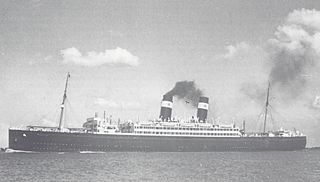History
Pre war
Cameronia was built for the Anchor Line, which was owned by Cunard Line. She was a sister ship to RMS Lancastria. Although she was launched in December 1919, a strike delayed her final completion. In April 1921, Cameronia was towed to Cherbourg, France for final fitting out. [4] She had accommodation for 265 1st class, 370 2nd class and 1,100 3rd class passengers. [3] Cameronia departed Glasgow on 11 May 1921 on her maiden voyage to Liverpool and New York. [4] Cameronia was placed under the management of the Henderson Brothers Ltd. Her port of registry was Glasgow. Her UK official number was 144242 and until 1933 her code letters were KHSQ. [2]
In October 1925, Cameronia rescued the crew of a United States Coast Guard cutter that had caught fire. She was in collision with the Norwegian steamship Hauk the following month. Her steering gear failed on a voyage in January 1926 and she returned to Glasgow for repairs. In August 1926, a collision with Cunard's Samaria was avoided by 6 feet (1.8 m). [3]
Cameronia underwent a refit in 1928 to correct her tendency to pitch heavily. In 1929 another refit saw her accommodation refitted to cabin/tourist class. [4] She now had accommodation for 290 cabin class, 431 tourist class and 698 3rd class passengers. [3] In 1934, Cameronia's code letters were superseded by the call sign GDXS. [5] She was laid up on the Clyde in December 1934. In 1935, the Anchor Line went into liquidation, and Cameronia was one of the assets purchased by Anchor Line (1935) Ltd. She remained laid up until the autumn of 1935, when she entered service as a troopship. In spring 1936, she was again refitted and returned to use as an ocean liner. [4] Cameronia participated in the 1937 Spithead Naval Review, [3] where she was used as a floating grandstand. [6]
Second World War
War was declared in September 1939. Cameronia departed Glasgow on 5 September. [3] During the voyage to New York, she rescued some of the survivors from Athenia, [7] and was the first British ship to enter New York after war had been declared. [3] Cameronia returned to the United Kingdom as part of Convoy HXF 1, which departed Halifax, Nova Scotia on 19 September 1939 and arrived at Liverpool on 29 September. Cameronia was bound for Glasgow. [8] She made eleven unescorted round trips from Glasgow – New York in the period to December 1940, when she was requisitioned for use as a troopship. [4] On 29 January 1941, Cameronia joined Convoy WS 5B at Freetown, Sierra Leone, sailing with the convoy to the Suez Canal, where she arrived on 3 March. [9] Cameronia was a member of Convoy GA 10, which arrived at Alexandria, Egypt on 6 April 1941. [10] On 23 March 1942, Cameronia departed the United Kingdom as a member of Convoy WS17, bound for Freetown. She departed Freetown on 11 April as part of Convoy WS17B bound for Cape Town, South Africa, arriving on 23 April. On 27 April, Cameronia departed Cape Town as part of Convoy WS 17 bound for Mombasa, Kenya, where she arrived on 8 May. On 10 May Cameronia departed Mombasa as part of Convoy WS 17BZ, arriving at Bombay, India on 19 May. [11] On 29–30 May 1941, she and the Glen Line's Glengyle evacuated 6,000 Argyll and Sutherland Highlanders from Sphakia at the end of the Battle of Crete. [12]
Cameronia served in the Mediterranean as a Landing Ship, Infantry during the war, taking part in the Allied invasion of French North Africa in November 1942. [3] On 22 December 1942, Cameronia was hit by a torpedo dropped by a Junkers Ju 88 of III Gruppe, KG 26 [13] off Algiers, Algeria. [14] A 288 square feet (26.8 m2) hole was blown in Cameronia's side [15] and 17 people were killed. [4] U-565 also claimed to have damaged her. [16] Cameronia managed to reach the port of Bougie, Algeria, from where she was escorted at 5 knots (9.3 km/h) to Algiers. She then sailed to Gibraltar where temporary repairs were carried out. [15] Cameronia then sailed to Glasgow for permanent repairs. [3] Repairs were completed in June 1943 and Cameronia was then returned to service. [4] On 29 August 1943, Cameronia departed Gibraltar as part of Convoy MKF 22, which had departed from Port Said, Egypt on 19 August and arrived at the Clyde on 9 September. [17] On 6 December 1943, Cameronia departed Oran, Algeria with members of the 21st General Hospital. They were landed at Naples, Italy on 21 December. [18] Cameronia was the largest troopship that took part in Operation Overlord in June 1944. [3] She served until the end of the war, when she was laid up. [4]
Post war
In 1947, Cameronia was returned to service on trooping duties to Palestine. [4] In 1948, she was refitted by Barclay, Curle & Co Ltd, Elderslie, giving her accommodation for 1,266 passengers in a single class. [3] She was used to transport people emigrating to Australia. [4] In 1953, Cameronia was sold to the Ministry of Transport and was renamed Empire Clyde, remaining under the management of Anchor Line. She served until 1957, arriving on 22 October at Newport, Monmouthshire for scrapping. [14]

SS Ceramic was an ocean liner built in Belfast for White Star Line in 1912–13 and operated on the Liverpool – Australia route. Ceramic was the largest ship serving the route until P&O introduced RMS Mooltan in 1923.

RMS Orion was an ocean liner launched by the Orient Steam Navigation Company in 1934 and retired from the water in 1963 after carrying about 500,000 passengers. A 23,371 ton passenger ship, the Orion was built to carry 486 first class, 653 tourist class passengers and 466 crew from Europe through the Pacific to Australia. The construction of the ship was documented in Paul Rotha's 1935 film Shipyard.

SS California was a British 16,792 GRT steam turbine ocean liner built in Glasgow in 1923 for the Anchor Line. She was a sister ship of Cameronia, Tyrrhenia, Tuscania, Transylvania and Caledonia. In 1939 the Royal Navy requisitioned her. She was bombed and abandoned along with the Duchess of York west of Spain by a Luftwaffe attack in July 1943.

SSCzar was an ocean liner for the then Russian American Line before World War I. In 1920-1930, the ship was named Estonia for the Baltic American Line, then named Pułaski for the PTTO and as a UK Ministry of War Transport troopship, and as Empire Penryn after World War II. The liner was built in Glasgow for the Russian American Line in 1912 and sailed on North Atlantic routes from Liepāja (Libau) to New York. On one eastbound voyage in October 1913, Czar was one of ten ships that came to the aid of the burning Uranium Line steamer Volturno.

SS Letitia was an ocean liner built in Scotland for service with the Anchor-Donaldson Line. She continued to serve with its successor company Donaldson Atlantic Line. At the start of the Second World War in September 1939, the British Admiralty requisitioned the ship for service and had it converted to serve as an armed merchant cruiser. She was withdrawn from this service in 1941 to become a troop ship.

RFA Maine was a 7,432 GRT hospital ship which was built in 1924 as the ocean liner Leonardo da Vinci by SA Ansaldo, La Spezia, Italy for the Società di Navigazione Transatlantica Italiana. In 1941, she was captured by the British at Kismayu, Italian Somaliland. Declared a prize of war, she was passed to the Ministry of War Transport (MoWT) and renamed Empire Clyde, serving as a hospital ship for the British Army during the Second World War. In 1948, ownership was passed to the Admiralty and she entered service with the Royal Fleet Auxiliary as RFA Maine. She served during the Korean War and was scrapped in 1954.

HMS Blackmore(pennant number L43) was an escort destroyer of the Type II Hunt class. The Royal Navy ordered Blackmore's construction three months after the outbreak of the Second World War. A. Stephen & Sons laid down her keel at their Glasgow yard on 10 February 1941, as Admiralty Job Number J1479. The ship was adopted by the civil community of Langport, Somerset after a successful Warship Week campaign. The ship was sold to the Royal Danish Navy and renamed HDMS Esbern Snare.
Empire Capulet was a 7,044 GRT cargo ship which was built in 1943 for the Ministry of War Transport (MoWT). In 1946 she was sold and renamed Hesione. She served until 1960 when she was scrapped.

Inkosi was a 6,618 GRT refrigerated cargo liner which was built by Swan, Hunter & Wigham Richardson Ltd, Newcastle upon Tyne for the Ministry of War Transport (MoWT). She was hired by the Royal Navy in 1940 for use as an ocean boarding vessel, but was sunk in an air raid before she could be used for this purpose. The ship was salvaged, converted to a cargo ship and passed to the Ministry of War Transport (MoWT), who renamed her Empire Chivalry. In 1946 she was sold and renamed Planter. She served until 1958, when she was scrapped.

Convoy Faith was a small, fast Allied convoy of World War II. It suffered heavy casualties when attacked by German long-range bombers while en route from Britain to West Africa in July 1943. The convoy comprised two large troopships and a freighter, later joined by two destroyers and two frigates as escorts at various dates after it sailed on 7 July 1943. The two troopships, SS California and SS Duchess of York, both former liners, were carrying military personnel to West Africa, where locally recruited troops were to be embarked as reinforcements for the Allied forces in Burma and the Middle East. The freighter MV Port Fairy, carrying ammunition, was ultimately bound for Australia and New Zealand via the Panama canal.
Guiding Star was a 7,248 GRT troopship that was built in 1939 as the Type C2 cargo ship Nightingale by Newport News Shipbuilding & Dry Dock Co, Newport News, Virginia, United States for Grace Lines Inc, New York. In 1941, she was transferred to the Ministry of War Transport (MoWT) and renamed Empire Egret. In 1942, she was transferred to the United States Maritime Commission (USMC) and renamed Nightingale. She was returned to Grace Lines later that year and renamed Santa Isabel. In 1943, she was converted to a troopship. She was transferred to the USMC in 1946 and renamed Guiding Star, serving until she was scrapped in 1973.

HMS Witch (D89) was a Modified W-class destroyer of the British Royal Navy that saw service in World War II.

QSMV Dominion Monarch was a UK passenger and refrigerated cargo liner. Her name was a reference to the Dominion of New Zealand. The unusual prefix "QSMV" stood for quadruple-screw motor vessel.

RMS Duchess of Atholl was one of a class of four steam turbine ocean liners built in Glasgow in 1927–29 for Canadian Pacific Steamships Ltd's transatlantic service between Britain and Canada.

Christiaan Huygens was a Dutch ocean liner that was built in 1927 by the Nederlandsche Scheepsbouw Maatschappij for the Stoomvaart Maatschappij Nederland (SMN). She was employed on the Amsterdam – Batavia route until the outbreak of the Second World War. Requisitioned as a troopship, she was employed in the Mediterranean Sea and Indian Ocean. Surviving the end of the war in Europe, she struck a mine in the Scheldt on 26 August 1945 and was beached. She broke in two on 5 September and was declared a total loss.

SS Pennland was a transatlantic ocean liner that was launched as Pittsburgh in Ireland in 1920 and renamed Pennland in 1926. She had a succession of UK, German and Dutch owners and operators. In 1940 she was converted into a troopship.

SS Cathay was a P&O passenger steamship that was built in Scotland in 1925 and sunk in the Mediterranean Sea in 1942. In the Second World War she was first an armed merchant cruiser and then a troop ship. In 1942 she took part in Operation Torch, and was sunk in a German air raid off Bougie, Algeria.
RMS Andes was a 26,689 GRT steam turbine Royal Mail Ship, ocean liner, cruise ship, and the flagship of the Royal Mail Lines fleet. She was the second Royal Mail ship to be named after the South American Andes mountain range. The first RMS Andes was an A-class liner launched in 1913. In 1929 that RMS Andes was converted into a cruise ship and renamed Atlantis.

SS Stratheden was a UK-built steam turbine ocean liner. She spent most of her career with the Peninsular and Oriental Steam Navigation Company, including the Second World War when she served for six years as a troop ship.
HMS Tasajera(F125) was a Maracaibo-class Mark I landing ship, tank of the Royal Navy during World War II. A converted Lake Maracaibo oil tanker.
















